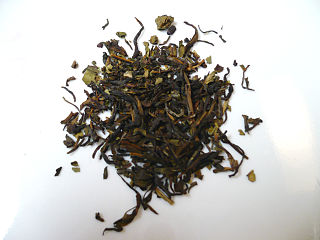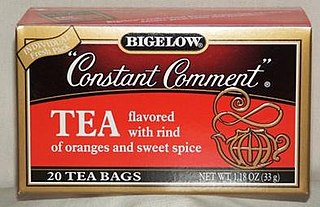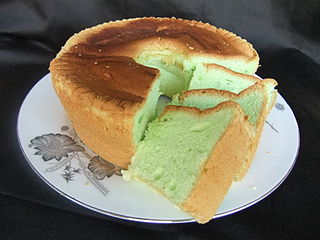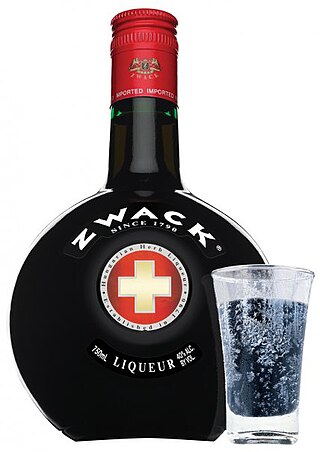
Tea is an aromatic beverage prepared by pouring hot or boiling water over cured or fresh leaves of Camellia sinensis, an evergreen shrub native to East Asia which probably originated in the borderlands of southwestern China and northern Myanmar. Tea is also made, but rarely, from the leaves of Camellia taliensis. After plain water, tea is the most widely consumed drink in the world. There are many different types of tea; some have a cooling, slightly bitter, and astringent flavour, while others have profiles that include sweet, nutty, floral, or grassy notes. Tea has a stimulating effect in humans, primarily due to its caffeine content.

Lapsang souchong or Zhengshan xiaozhong is a black tea consisting of Camellia sinensis leaves that may be smoke-dried over a pinewood fire. This smoking is accomplished either as a cold smoke of the raw leaves as they are processed or as a hot smoke of previously processed leaves. The intensity of the smoke aroma can be varied by locating the leaves closer or farther from the source of heat and smoke or by adjusting the duration of the process. The flavour and aroma of smoked lapsang souchong is described as containing empyreumatic notes, including wood smoke, pine resin, smoked paprika, and dried longan; it may be mixed with milk but is not bitter and usually not sweetened with sugar. The tea originates from the Wuyi Mountains region of Fujian and is considered a Wuyi tea. It is also produced in Taiwan. It has been labelled as smoked tea, smoky souchong, tarry lapsang souchong and lapsang souchong crocodile. While the tea leaf grading system adopted the term souchong to refer to a particular leaf position, lapsang souchong may be made with any leaf of the Camellia sinensis plant, though it is not unusual for the lower leaves, which are larger and less flavourful, to be used as the smoking compensates for the lower flavour profile and the higher leaves are more valuable for use in unflavoured or unblended teas. In addition to its consumption as a tea, lapsang souchong is also used in stock for soups, stews and sauces or otherwise as a spice or seasoning. Beginning in the early 21st century, an unsmoked variety of lapsang souchong was developed in the village of Tong Mu Guan in the Wuyi mountains. The unsmoked variety has become increasingly popular, particularly in the Chinese domestic market.

Citrus limetta, alternatively considered to be a cultivar of Citrus limon, C. limon 'Limetta', is a species of citrus, commonly known as mousami, musami, sweet lime, sweet lemon, and sweet limetta, it is a member of the sweet lemons. It is small and round like a common lime in shape. It is a cross between the citron and a bitter orange.
Prince of Wales tea blend is a blend of Keemun tea, gunpowder green tea, and a dash of currant juice or infused with dried currants. This produces a full-bodied cup with a bright liquor and strong aroma. It was named after Edward, Prince of Wales, who held that title from 1911 until 1936.

Nilgiri tea is a drink made by infusing leaves of Camellia sinensis that is grown and processed in the Nilgiris district in Tamil Nadu, India. The leaves are processed as black tea, though some estates have expanded their product offerings to include leaves suitable for making green, white and oolong teas. It is generally described as being a brisk, fragrant and full-bodied tea. The region produces both rolled and crush, tear, curl tea and it is predominantly used for blending. Nilgiri tea is also used for making iced tea and instant tea.

R.C. Bigelow, Inc. is an American manufacturer of dried teas based in Fairfield, Connecticut. It was founded by Ruth C. Bigelow in 1945, based on a recipe she marketed as "Constant Comment" tea. The company markets over 50 varieties of tea, including black, green and herbal, all of which are blended in Fairfield. The company has other plants in Boise, Idaho, and Louisville, Kentucky. Their Charleston Tea Garden in South Carolina is the only tea garden in America, but it does not produce the company's teas. Still a 100% family-owned business, Bigelow employs 350 people and had annual sales in 2020 of approximately US$188.9 million.

Citrus bergamia, the bergamot orange, is a fragrant citrus fruit the size of an orange, with a yellow or green colour similar to a lime, depending on ripeness.

Tea culture is defined by how tea is made and consumed, how people interact with tea, and the aesthetics surrounding tea drinking.

Twinings is a British marketer of tea and other beverages, including coffee, hot chocolate and malt drinks, based in Andover, Hampshire. The brand is owned by Associated British Foods. It holds the world's oldest continually used company logo, and is London's longest-standing ratepayer, having occupied the same premises on the Strand since 1706. Twinings tea varieties include black tea, green tea and herbal teas, along with fruit-based cold infusions.

Tea blending is the act of blending different teas together to produce a final product that differs in flavor from the original tea used. This occurs chiefly with black tea, which is blended to make most tea bags, but it can also occur with such teas as Pu-erh, where leaves are blended from different regions before being compressed. The most prominent type of tea blending is commercial tea blending, which is used to ensure consistency of a batch on a mass scale so that any variations between different batches and seasons of tea production do not affect the final product. However, it is also common to blend tea leaves with herbs and spice, either for health purposes or to add interesting and more complex flavor notes. It is important that any one blend must taste the same as the previous one, so a consumer will not be able to detect a difference in flavor from one purchase to the next.

Pandan cake is a light, fluffy, green-coloured sponge cake flavoured with the juices of Pandanus amaryllifolius leaves. It is also known as pandan chiffon. The cake is popular in Malaysia, Indonesia, Singapore, Vietnam, Cambodia, Laos, Thailand, Sri Lanka, Hong Kong, China, and also the Netherlands. It is similar to the buko pandan cake of the Philippines, but differs in that it does not use coconut.

Irish breakfast tea is a blend of several black teas, most often a combination of Assam teas and Ceylon teas. Irish tea brands, notably Barry's, Bewley's, Lyons and Robert Roberts in the Republic and Nambarrie's and Thompson's Punjana in Northern Ireland are heavily weighted towards Assam. It is one of the most popular blended teas, common in tea culture in Ireland. When tea was first transported from China to Ireland in the mid-18th century, it was mainly introduced to the wealthy as a result of its high cost and low demand. However, throughout the mid-19th century, Irish breakfast tea became readily available to those of both lower and higher socioeconomic classes.

Howick is a village and former civil parish, now in the parish of Longhoughton, in Northumberland, England, between Boulmer and Craster. It is just inland from the North Sea, into which Howick Burn flows from Howick Hall. In 1951 the parish had a population of 246.

Lipton is a British brand of tea, soup, and dipping sauce, owned by Lipton Teas and Infusions. Lipton was also the name of a supermarket chain in the United Kingdom, owned by Allied Suppliers, which was sold to Argyll Foods in 1982, after which the brand was used only for tea, soup, and dipping sauce. The company, which is named after its founder, Sir Thomas Lipton, who started the business it in 1890, was owned by Unilever for many decades until its sale to CVC Capital Partners in 2022. Lipton’s ready to drink beverages are sold by "Pepsi Lipton International", a company jointly owned by Unilever and PepsiCo.

Lady Grey tea is a trademarked variation on Earl Grey tea. Like Earl Grey, it is a black tea flavoured with bergamot essential oil.

Zwack is a Budapest, Hungary-based company that makes liqueurs and spirits. The company produces an 80 U.S. proof herbal liqueur known as Unicum from a secret blend of more than forty different herbs and spices. Unicum is known as one of the national drinks of Hungary.

Bergamot essential oil is a cold-pressed essential oil produced by cells inside the rind of a bergamot orange fruit. It is a common flavoring and top note in perfumes. The scent of bergamot essential oil is similar to a sweet light orange peel oil with a floral note.

Black tea is a type of tea that is more oxidized than oolong, yellow, white and green teas. Black tea is generally stronger in flavour than other teas. All five types are made from leaves of the shrub Camellia sinensis, though Camellia taliensis is also used rarely.

A London fog is a hot tea-based drink that consists of Earl Grey tea, steamed milk, and a sweetener.





















